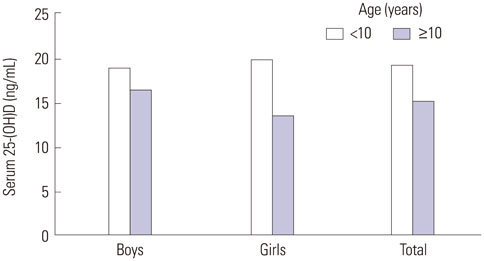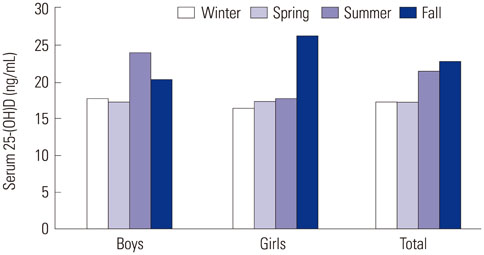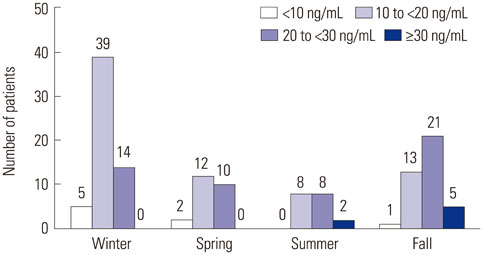Yonsei Med J.
2015 Sep;56(5):1384-1388. 10.3349/ymj.2015.56.5.1384.
Prevalence of Vitamin D Deficiency in Korean Children Presenting with Nonspecific Lower-Extremity Pain
- Affiliations
-
- 1Department of Orthopedic Surgery, National Health Insurance Service Ilsan Hospital, Goyang, Korea.
- 2Department of Orthopedic Surgery, Incheon St. Mary's Hospital, College of Medicine, The Catholic University of Korea, Incheon, Korea. sjoo@catholic.ac.kr
- KMID: 2163633
- DOI: http://doi.org/10.3349/ymj.2015.56.5.1384
Abstract
- PURPOSE
Although interest in the role played by vitamin D in bone health is increasing, little is known about the role of this vitamin in musculoskeletal pain in children. This study aimed to assess the prevalence of vitamin D deficiency in children presenting with nonspecific lower extremity pains.
MATERIALS AND METHODS
From 2011 to 2012, 183 children underwent evaluation for nonspecific lower-extremity pains. Patients with valid causes, such as fractures or transient synovitis, were excluded, as were those with underlying medical conditions, such as cerebral palsy and metabolic disease. Ultimately, 140 patients met the inclusion criteria. Levels of serum 25-hydroxy vitamin D [25-(OH)D], the ideal indicator of vitamin D status, were measured in these children.
RESULTS
Eighty-seven boys (62.1%) and 53 girls (37.9%) were included. The mean age at presentation was 5.2 years (range, 2-15). Serum 25-(OH)D levels were <10 ng/mL in 5.7% of patients, 10 to <20 ng/mL in 51.4%, 20 to <30 ng/mL in 37.9%, and > or =30 ng/mL in only 5.0%. Most patients visited the hospital in the winter (41.4%) (summer, 12.9%), and serum 25-(OH)D levels were also lowest in the winter (17.2+/-5.5 ng/mL).
CONCLUSION
This study found a high prevalence of vitamin D deficiency or insufficiency in Korean children with nonspecific lower-extremity pains, indicating a positive association between vitamin D deficiency and growing pains. More attention should be directed toward vitamin D and its role in the optimization of bone health.
Keyword
MeSH Terms
-
Adolescent
Asian Continental Ancestry Group/*statistics & numerical data
Calcifediol/administration & dosage
Child
Child, Preschool
Cross-Sectional Studies
Female
Humans
Male
Musculoskeletal Pain/drug therapy/etiology
Prevalence
Republic of Korea/epidemiology
Retrospective Studies
Seasons
Vitamin D/*analogs & derivatives/blood
Vitamin D Deficiency/blood/complications/*ethnology
Vitamins/administration & dosage
Calcifediol
Vitamin D
Vitamins
Figure
Reference
-
1. Peterson H. Growing pains. Pediatr Clin North Am. 1986; 33:1365–1372.
Article2. Abu-Arafeh I, Russell G. Recurrent limb pain in schoolchildren. Arch Dis Child. 1996; 74:336–339.3. Williams MF. Rheumatic conditions in school children. Lancet. 1928; 211:720–721.4. Pavone V, Lionetti E, Gargano V, Evola FR, Costarella L, Sessa G. Growing pains: a study of 30 cases and a review of the literature. J Pediatr Orthop. 2011; 31:606–609.5. Holick MF. Vitamin D deficiency. N Engl J Med. 2007; 357:266–281.6. Bischoff HA, Borchers M, Gudat F, Duermueller U, Theiler R, Stähelin HB, et al. In situ detection of 1,25-dihydroxyvitamin D3 receptor in human skeletal muscle tissue. Histochem J. 2001; 33:19–24.7. Davies JH, Reed JM, Blake E, Priesemann M, Jackson AA, Clarke NM. Epidemiology of vitamin D deficiency in children presenting to a pediatric orthopaedic service in the UK. J Pediatr Orthop. 2011; 31:798–802.
Article8. McNally JD, Matheson LA, Rosenberg AM. Epidemiologic considerations in unexplained pediatric arthralgia: the role of season, school, and stress. J Rheumatol. 2009; 36:427–433.
Article9. Yoon JH, Park CS, Seo JY, Choi YS, Ahn YM. Clinical characteristics and prevalence of vitamin D insufficiency in children less than two years of age. Korean J Pediatr. 2011; 54:298–303.10. Kim SH, Oh MK, Namgung R, Park MJ. Prevalence of 25-hydroxyvitamin D deficiency in Korean adolescents: association with age, season and parental vitamin D status. Public Health Nutr. 2014; 17:122–130.11. Rockell JE, Green TJ, Skeaff CM, Whiting SJ, Taylor RW, Williams SM, et al. Season and ethnicity are determinants of serum 25-hydroxyvitamin D concentrations in New Zealand children aged 5-14 y. J Nutr. 2005; 135:2602–2608.
Article12. Lips P. Vitamin D physiology. Prog Biophys Mol Biol. 2006; 92:4–8.13. Ward KA, Das G, Berry JL, Roberts SA, Rawer R, Adams JE, et al. Vitamin D status and muscle function in post-menarchal adolescent girls. J Clin Endocrinol Metab. 2009; 94:559–563.14. Foo LH, Zhang Q, Zhu K, Ma G, Hu X, Greenfield H, et al. Low vitamin D status has an adverse influence on bone mass, bone turnover, and muscle strength in Chinese adolescent girls. J Nutr. 2009; 139:1002–1007.
Article15. Plotnikoff GA, Quigley JM. Prevalence of severe hypovitaminosis D in patients with persistent, nonspecific musculoskeletal pain. Mayo Clin Proc. 2003; 78:1463–1470.
Article16. Heidari B, Shirvani JS, Firouzjahi A, Heidari P, Hajian-Tilaki KO. Association between nonspecific skeletal pain and vitamin D deficiency. Int J Rheum Dis. 2010; 13:340–346.
Article17. Szalay EA, Tryon EB, Pleacher MD, Whisler SL. Pediatric vitamin D deficiency in a southwestern luminous climate. J Pediatr Orthop. 2011; 31:469–473.
Article
- Full Text Links
- Actions
-
Cited
- CITED
-
- Close
- Share
- Similar articles
-
- Four Cases of Vitamin D Deficiency Rickets with Lower Extremity Deformities
- Two Cases of Megaloblastic Anemia Induced by Vitamin B12 Deficiency in Children
- Prevalence and risk factors for vitamin D deficiency in children with iron deficiency anemia
- Serum vitamin D status in children and adolescence with diabetes according to season and age
- Recent Updates on Vitamin D and Pediatric Gastrointestinal Diseases




